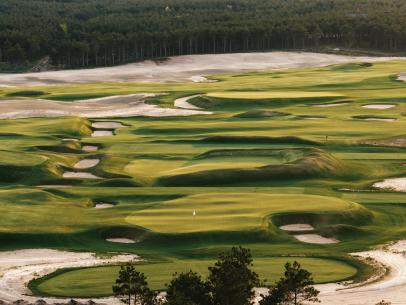Coming off the success of his masterpiece design at National Golf Links of America in 1911, a course he created to broadcast to the world the full potential of golf in the United States, C.B. Macdonald turned his attention to another groundbreaking task, The Lido. Located on the south shore of Long Island on a parcel of beachside swamp and underbrush, The Lido would represent one of the most ambitious and audacious course construction endeavors ever attempted.
The site required over two million cubic yards of sand be piped onto the site for backfill—an astronomical amount for a golf course in 1914—which was then manually shaped into tall dunes, giant green pads and steep bunkers before 35,000 tons of topsoil was applied. The links-inspired holes were enormous, difficult and brazen, and when The Lido opened in 1917 it became a wonder of the world for the technical achievement of building it, and it was described by many as one of the country’s greatest courses.
RELATED: I got to play the new Lido course at Sand Valley. Here’s what makes it so unique
But hard economic times befell The Lido almost immediately, through World War I and again during the Great Depression. The Navy acquired the land during World War II and razed the course, replacing golf with an air base.
Over 75 years later, Michael and Chris Keiser, proprietors of Sand Valley in Wisconsin, attempted another groundbreaking task: resurrecting The Lido. Using a never-before-attempted combination of computer-generated animation of the original course (based on historical documents), GPS laser mapping and the expertise of architect Tom Doak and his associates, The Lido was rebuilt on a 225-acre field of sand in exacting detail, with each hole and every Macdonald feature replicated down to, in many cases, the square inch.
RELATED: Rebuilding The Lido at Sand Valley: Tom Doak reflects on reviving a lost classic
The Lido opened in 2023, and though architects, golfers and historians have been studying it through photographs and writings for several generations, nothing could prepare them for the shock of seeing its size and contours and proportions in person.
To fully take in The Lido has to be experienced first-hand, but until then this video will help acclimated you to one of golf’s new wonders of the world.
 Public Sand Valley: The Lido Nekoosa, WI
Public Sand Valley: The Lido Nekoosa, WI
The Lido at Sand Valley in central Wisconsin opened in May, 2023, and is a down-to-the-inch recreation of The Lido that C.B. Macdonald built on Long Island from 1914 to 1917. Heralded as one of the country’s greatest courses, it went extinct in the 1940s when the U.S. government converted the land to a naval base. Rebuilding The Lido has been the fantasy of many historians, but doing so accurately became possible when Peter Flory, a financial consultant and architecture enthusiast, developed a detailed computer simulation of the course based on scrupulous study of old photographs and other material. Sand Valley proprietors Michael and Chris Keiser discovered Flory’s computer model, then asked architect Tom Doak if he could use it to rebuild the course. First the animated contours had to be translated into a physical GPS topographical blueprint, a technological hack accomplished by digital mapping specialist Brian Zager. The GPS map enabled Doak and his associates to reconstruct Lido holes like Plateau, Alps, Cape and Long in exquisite detail, along with originals like the Dog’s Leg sixth and the Home 18th, making only minor adjustments for drainage and adding longer tees for modern play. Though there’s no Atlantic Ocean crashing near the Biarritz eighth green or stiff coastal winds swatting around balls, the ”new” Lido is a stunning representation of Macdonald’s groundbreaking accomplishment and a vivid throwback to a more daring era of architecture. Using the spacious hole corridors to explore different routes into the giant greens is half the fun. Contemplating players navigating holes like the Channel fourth, with an alternative island fairway for daring hitters and a green perched behind a high rampart bunker, using hickory shafts and Haskell balls, is the other half.
Explore our full review More from Golf Digest  Bucket List 10 courses I really want to play in 2024
Bucket List 10 courses I really want to play in 2024
• • •
Explore Golf Digest’s new Course Reviews section where you can submit a star rating and evaluation on all the courses you’ve played. We’ve collected tens of thousands of reviews from our course-ranking panelists to deliver a premium experience, which includes course rankings, experts’ opinions, bonus course photography, videos and much more. Check it out here!
This article was originally published on golfdigest.com



